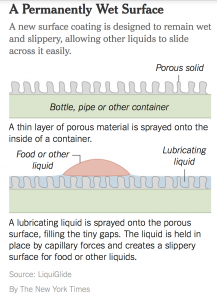Have you ever attempted to scoop out the remaining honey with fingers in a container? Have you ever squeezed really hard to get the last bit of a toothpaste? Is the little bit clingy glue in the bottom of the bottle really annoyed you when you try to use it?
A company called LiquiGlide discovered a new nonstick coating can let the above problems go away. The basic idea is to use this special coating to make the inside of container slippery so that the liquid will slide back into the bottom instead of sticking to the lid and drying there. In addition, a test by Consumer Reports in 2009 indicated that much of what we buy never makes it out of the container and is instead thrown away — up to a quarter of skin lotion, 16 percent of laundry detergent and 15 percent of condiments like mustard and ketchup. Therefore, If this material is widely used in daily life, we can save resources and reduce waste. Bingham plastics is the most common material that is used in traditional container manufacturing. Bingham plastic is named after Eugene Bingham, a chemist who proposed the mathematical properties. This material is highly viscous and does not flow without a strong push.

This picture shows the average waste and the differences between new nonstick coatings and traditional coatings. (source)
The key to success this technology is to find a material that has superhydrophobic surfaces. Superhydrophobic surfaces are non-wettable surfaces with high water contact angles and facile sliding of drops. The superhydrophobic surface is rough under a microscope. Water rolls up into balls, sitting on the tips of the rough surface, but mostly on air trapped between the droplet and the rough surface. The droplets roll off easily. In this new material, the lubricant binds more strongly to the textured surface than to the liquid, and that allows the liquid to slide on a layer of lubricant instead of being pinned against the surface, and the textured surface keeps the lubricant from slipping out. However, finding a proper material is not easy. If the microscopic roughness is damaged, water will flow in and displace the pockets of air, then stick to the no-longer-slippery surface. Since air can dissolve into the water if superhydrophobic surfaces are submerged in water for long periods, it will become rough. As a result, detergents or lotions will stick on the wall of containers.

This picture describes how superhydrophobic surface works in this new material. (source)
In the future, the company wants to explore further on the industrial applications including coatings for petroleum storage tanks and pipelines. If these applications can succeed, less energy needed to push materials through the pipes, fewer chemicals required cleaning the pipes.
Written by Nancy Ma
